Motorists around the world are becoming increasingly comfortable with purchasing and owning EVs, according to a new study, though Americans lag well behind their counterparts in Europe and, in particular, China. Credit the longer range, faster charging and lower costs of newer EV models, consumers told McKinsey & Co. Headlight.News has more.
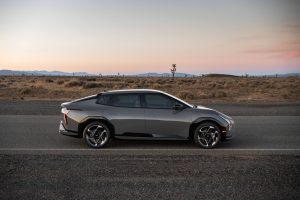
The 2026 Kia EV4 becomes the more affordable sibling to the brand’s original EV6 battery-electric vehicle.
Are you ready to buy a plug-based vehicle? How you answer may depend on where you live. More than eight in ten Chinese motorists are ready to go with an EV or plug-in hybrid next time they’re in the market for a new vehicle. In Europe it’s a fully half. In the U.S., however, the number is barely three in ten, according to McKinsey & Co.’s latest Consumer Pulse study.
Even then, the numbers vary sharply depending upon whom you ask. In the U.S., acceptance of EVs and PHEVs is strongest along the East and West Coasts, with Californian motorists nearly as interested in plug models as their counterparts in China. Younger drivers and those living in urban areas are, meanwhile, more into battery power than those born before 1981 or living in rural communities, the study reveals.
Some of the findings came as a surprise to McKinsey researchers. The owners surveyed in the U.S. were notably more pleased with the ownership experience than they were a year ago, reflecting improvements in range and charging speeds, as well as falling EV prices. Even so, the numbers of American motorists expecting to buy a plug model, whether EV or PHEV, was largely unchanged from the 2024 Consumer Pulse study.
A tale of two coasts
 “In the U.S., the sentiment towards battery-electric vehicles hasn’t changed over time,” said Phillip Kampshoff, co-founder of McKinsey’s Center for Future Mobility. “The one big change” has been the growth in interest in plug-in hybrid electric vehicles – which many in the auto industry see as a long-term “bridge” to EVs because they reduce concerns about range anxiety and charging times.
“In the U.S., the sentiment towards battery-electric vehicles hasn’t changed over time,” said Phillip Kampshoff, co-founder of McKinsey’s Center for Future Mobility. “The one big change” has been the growth in interest in plug-in hybrid electric vehicles – which many in the auto industry see as a long-term “bridge” to EVs because they reduce concerns about range anxiety and charging times.
This year’s Consumer Pulse study found 12% of U.S. motorists saying they expect to buy an electric vehicle next time they’re in the market. A slightly higher 17% said they expect their next vehicle will be a PHEV. By comparison, 23% of Europeans want an EV, 27% expecting to buy a plug-in hybrid. Among Chinese motorists, the figures were 45 and 37% respectively.
In the States, meanwhile, there’s a marked difference depending upon who you ask, depending upon where they live and how old they are. “It’s a tale of two coastal areas,” said Kampshoff, with the strongest demand in California and, to a lesser degree in states like Oregon, New York and Florida.
Urbanites are more interested in going electric than rural motorists, perhaps reflecting issues like range anxiety. And there was a marked increase in interest among those born since 1981, said the McKinsey analyst, adding, “We don’t see the same interest in older part of the population.”
EV owners increasingly satisfied
 Demand for EVs, in particular, surged about 800% between 2019 and 2023 before slowing down last year. Industry sales data suggest that leveling off of sales growth came as manufacturers saturated the market among environmentally minded motorists and early adopters, shifting focus to mainstream buyers.
Demand for EVs, in particular, surged about 800% between 2019 and 2023 before slowing down last year. Industry sales data suggest that leveling off of sales growth came as manufacturers saturated the market among environmentally minded motorists and early adopters, shifting focus to mainstream buyers.
But there are positive signs suggesting EV and PHEV sales have far from plateaued. Notably, McKinsey found that 76% of those motorists who currently own an EV plan to get another one when its time to trade in, while 15% will switch to a PHEV. A year ago, 46% of EV owners said they were ready to return to a vehicle relying solely on an internal combustion engine.
“EV satisfaction has increased quite significantly,” said Kampshoff, suggesting several factors have come into play,
More EV News
- EV Sales Could Tumble as Trump, GOP Raise New Barriers
- For Now, EV Sales Exceeding Forecasts
- Tesla Share of California EV Market Drops Below 50%
What’s changed?
 For one thing, newer models tend to be offering longer range than earlier EVs. And not only are they generally able to charge faster but there are more places to charge in while away from home. The number of DC public quick chargers rose about 50% last year, said Kampshoff, and a growing number of brands now make it possible for owners to plug into the extensive Tesla Supercharger network.
For one thing, newer models tend to be offering longer range than earlier EVs. And not only are they generally able to charge faster but there are more places to charge in while away from home. The number of DC public quick chargers rose about 50% last year, said Kampshoff, and a growing number of brands now make it possible for owners to plug into the extensive Tesla Supercharger network.
There’s also the improved reliability of those public chargers. In recent years, reports of faulty chargers have become commonplace but McKinsey data indicates there’s been a 10 to 15% decrease in downtime so, “If you drive up to a charger now there’s a much better change it will be working,” said Kampshoff.
Add the fact that the number of new EVs using 800-volt electric systems, rather than older, slower 400-volt technology has tripled over the last year and will continue increasing. That means many EVs now can go from a 10 to 80% state-of-charge in around 30 minutes.
Another plus: prices for plug-based models have begun falling in the face of increased competition. Combined with their inherent lower energy costs that has improved the cost-of-ownership equation.
Prices need to keep falling
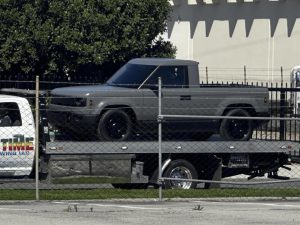
A spy shot shows what is believed to be a prototype of the new Slate Auto’s $25,000 electric pickup.
That said, affordability is still a challenge, especially in the U.S. where EVs still tend to average about $5,000 higher in price than comparable ICE models.
That’s less of an issue in China and some other regions of the world, including Southeast Asia, Latin America and Europe where low-cost Chinese brands like BYD and Geeley have staked out a presence. Many of their EVs are now priced below $30,000, and even less than $20,000. But the door has all but closed on Chinese EV exports to the U.S. due to tariffs first enacted by President Joe Biden and now by his successor Donald Trump.
What will it take to trigger the next big surge in EV demand? “You have to be able to sell cheap EVs. This is the $100 billion question,” Kampshoff said during a Tuesday videoconference with journalists.
The good news for potential EV buyers is that there are a number of new, low-cost models coming, such as the revived Chevrolet Bolt and the upcoming Kia EV4. Tesla has its own new entry model in the works though, as Headlight.News reported, it’s been delayed again. Slate Auto, a new EV start-up funded by Amazon founder Jeff Bezos, is expected this week to announce plans to launch production of a $25,000 electric pickup next year.
Loyalty matters – to a point
 Automakers put a premium on maintain brand loyalty. And, given that a manufacturer offers a competitive EV or PHEV it has a good shot at keeping buyers in the family when they switch from ICE to electric, McKinsey data revealed.
Automakers put a premium on maintain brand loyalty. And, given that a manufacturer offers a competitive EV or PHEV it has a good shot at keeping buyers in the family when they switch from ICE to electric, McKinsey data revealed.
That said, “We are seeing great interest in changing brands” among first time EV buyers, said Patrick Hertke, McKinsey’s global electric vehicle lead and automotive sector leader. And “At least half of owners on their second EV have switched brands.”
If anything, the McKinsey study found “a pretty stark gap” between younger buyers who are ready to switch to new brands – including EV start-ups – compared to older motorists.
Tesla trouble

Tesla CEO Elon Musk’s ties to Pres. Donald Trump are now seen as hurting the brand, said McKinsey experts.
Once the absolutely dominant brand in the EV market, Tesla’s share of U.S. sales slid from 80 to just under 50% over the last three years. First-quarter sales plunged by nearly half in Europe and were also down sharply in China and the U.S., according to industry data.
The growing number of competing products has clearly played a role. But while it took time for a “direct correlation” to become apparent, Kampshoff said it’s become increasingly clear the Texas-based EV company is taking hits as current owners and new EV customers respond negatively to CEO Elon Musk’s far right politics.
That’s good news for the competition, however, including those start-ups. “While people might move away from Tesla as a brand,” he said, “they still like battery-electric vehicles.”
Automakers need to become “much more surgical”
During the Biden era, automakers allocated tens of billions of dollars to bring more plug-based products to market and, in many cases, to lay out plans to go all-EV. In recent months, however, a number of brands have pulled back, often dropping or delaying products they questioned whether would generate the necessary levels of demand.
“Rather than going full-speed, betting on EVs,” said Kampshoff, “you have to be much more surgical,” focusing on products that will generate strong – and profitable – sales.
But manufacturers shouldn’t use this as an excuse to retreat from the EV market, he stressed. One of the dangers – made worse by the restrictions created by the new Trump auto tariffs – is “the risk of becoming complacent and not really being competitive anymore.”



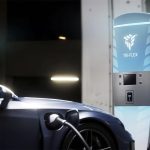
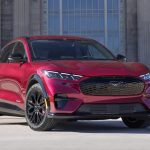


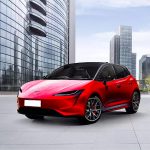
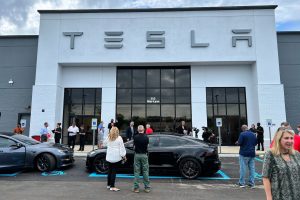
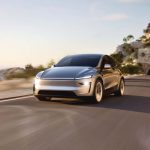
0 Comments